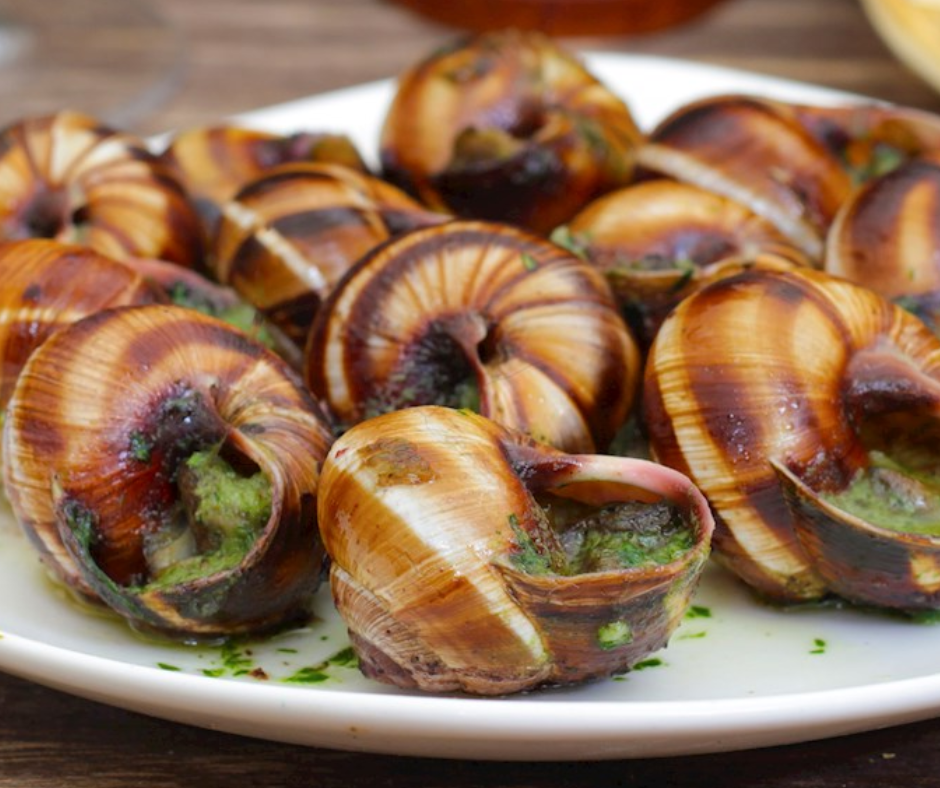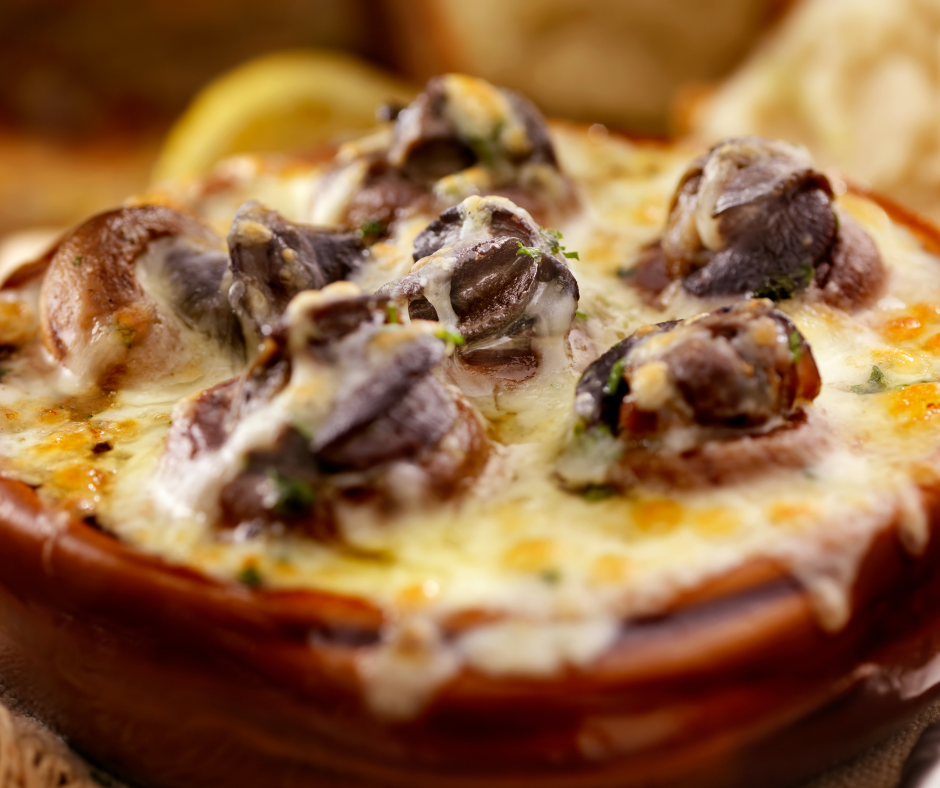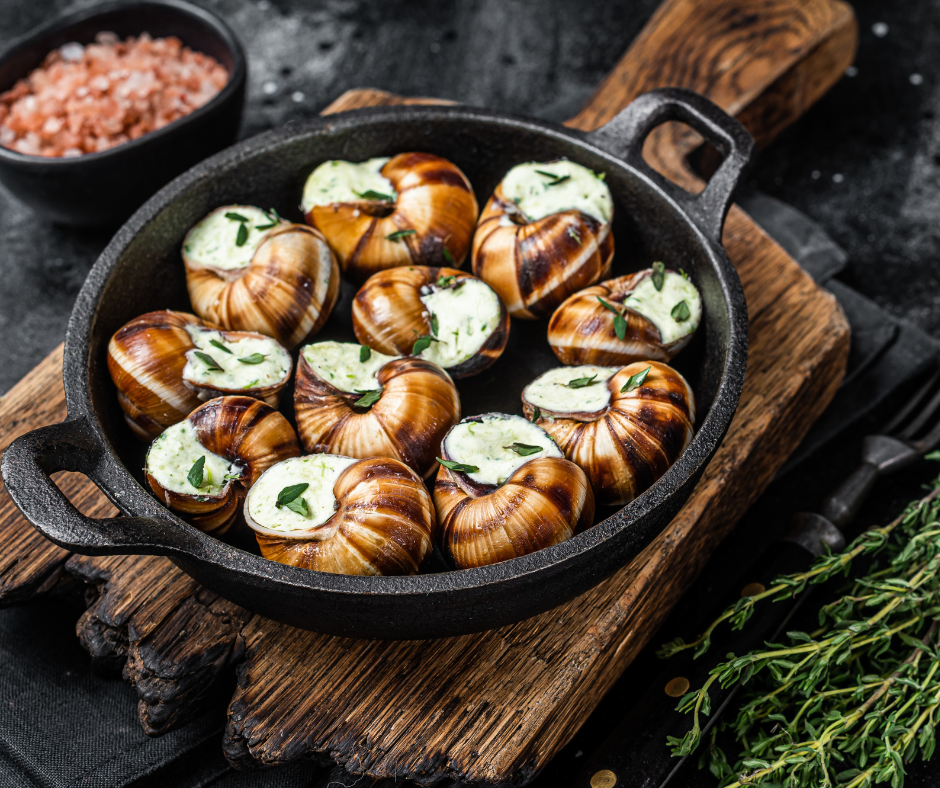Introduction To Escargot
Escargot, a French delicacy, has become increasingly popular worldwide. While some may be apprehensive about trying this gourmet dish, others are curious to delve into its unique flavor. This article will explore ‘What Does Escargot Taste Like?‘ and its significance in French cuisine.
What Is Escargot And Its Significance In French Cuisine
Escargot, derived from the French word for snail, refers to land snails typically cooked and enjoyed as a culinary delicacy. While eating snails may seem unconventional to some, it has been a part of French gastronomy for centuries. French cuisine is renowned for its emphasis on rich flavors and diverse ingredients, and escargot is a quintessential representation of this culinary tradition.
In French cuisine, escargot is often prepared using a classic recipe that involves removing the snail from its shell, cleaning and cooking it, and then placing it back into its shell with a flavorful herb and butter mixture. The dish is typically served as an appetizer, accompanied by crusty bread to soak up the delicious juices.
The Curiosity Behind The Unique Flavor Of Escargot
The unique flavor of escargot is certainly a matter of intrigue for many. The snails themselves have a mild, slightly earthy taste that can be likened to shellfish or mussels. However, what truly distinguishes the flavor of escargot is the combination of seasonings and sauces used during the cooking process.
The classic preparation method involves bathing the snails in decadent garlic and parsley butter. This infusion of flavors enhances the natural taste of the snails and imparts a rich, savory profile. The butter is a vehicle for the aromatics, infusing the dish with a delightful herbal essence.
Apart from the distinctive taste, the texture of escargot also adds to the overall experience. When properly cooked, the snails possess a tender yet slightly firm texture, ensuring a satisfying bite.
While escargot may not be to everyone’s taste, it is often considered a gourmet delicacy for those with an adventurous palate. Its unique flavor profile and significance in French cuisine make it an intriguing and sought-after dish for culinary enthusiasts worldwide.
What Does Escargot Taste Like?
Describing The Varying Taste Profiles Of Escargot
Escargot, the French delicacy consisting of land snails, has gained popularity worldwide for its unique flavor profile. So, What Does Escargot Taste Like? The taste of escargot can vary depending on factors such as the snail species, cooking method, and seasoning used. However, it is generally described as mild and slightly earthy. The snail has a subtle flavor that can be compared to shellfish or mussels. It develops a tender yet slightly firm texture that adds to the overall experience when cooked properly.
The true distinction in the taste of escargot comes from the infusion of flavors during the cooking process. The classic preparation method involves bathing the snails in decadent garlic and parsley butter. This combination of seasonings and sauces enhances the natural taste of the snails and imparts a rich, savory profile. The butter is a vehicle for the aromatics, infusing the dish with a delightful herbal essence.
Comparisons To Seafood And Other Familiar Flavors
For those unfamiliar with escargot, comparing its taste to other familiar flavors can be helpful. The mild and slightly earthy taste of escargot shares some similarities with shellfish, such as clams or mussels. However, escargot has a unique character that sets it apart from other seafood.
The garlic and parsley butter mixture used in the cooking process adds flavor to the snails. Combining herbs, garlic, and butter creates a rich and aromatic profile reminiscent of French cuisine.
While escargot may not be to everyone’s taste, it is often appreciated by those with an adventurous palate. Its distinct flavor profile and significance in French cuisine make it an intriguing and sought-after dish for culinary enthusiasts worldwide.
In conclusion, tasting escargot reveals a mild and slightly earthy flavor with a tender yet slightly firm texture. The infusion of flavors from the garlic and parsley butter mixture adds depth and richness to the dish. Although it can be compared to seafood, escargot has a unique taste that sets it apart. For those willing to venture into the world of gourmet delicacies, escargot provides an intriguing and flavorful experience.
Exploring The Texture Of Escargot
Addressing The Misconceptions About The Slimy Texture Of Escargot
Escargot, often referred to as the French delicacy, is a dish that can evoke mixed reactions due to its perceived slimy texture. However, it is important to address some misconceptions surrounding the texture of escargot and provide a more accurate understanding.
Contrary to popular belief, properly cooked escargot has no slimy texture. The snails are typically removed from their shells and cooked to perfection, resulting in a tender yet slightly firm mouthfeel. This texture is similar to well-cooked shellfish, such as mussels or clams.
The unique texture of escargot is an important aspect of its appeal. When cooked properly, the snails acquire a delightful chewiness that adds to the overall experience of the dish. This texture allows the flavors to develop fully, creating a harmonious balance between richness and tenderness.
Understanding The Texture And Mouthfeel Of Cooked Snails
Cooked snails, when prepared correctly, offer a satisfying texture that is far from slimy. The snails are typically blanched and then cooked in a buttery mixture that infuses them with rich flavors. This cooking process enhances the texture of the snails, giving them a pleasing mouthfeel akin to velvety seafood.
The tenderness of the cooked snails allows them to melt in your mouth, offering a delightful eating experience. The flavors of the snails blend with the garlic and parsley butter mixture, creating a cohesive and satisfying texture that is both enjoyable and memorable.
It is also worth mentioning that the texture of escargot can vary slightly depending on the snail species and the cooking method used. Some species may have a slightly firmer texture, while others may be more delicate. However, regardless of these variations, properly cooked escargot should never have a slimy or unpleasant texture.
In conclusion, addressing the misconceptions about the slimy texture of escargot is crucial to understanding the true experience of this French delicacy. When cooked properly, escargot offers a tender yet slightly firm texture that enhances the overall enjoyment of the dish. The misconception surrounding the sliminess of escargot should not deter adventurous food enthusiasts from experiencing its unique and flavorful profile.
Preparing Escargot
Escargot, often considered a French delicacy, requires careful preparation to bring out its unique flavors. Here, we will delve into the various methods for cooking and serving escargot and popular sauces and seasonings that can elevate its flavor profile.
Methods For Cooking And Serving Escargot
There are several methods for cooking escargot to perfection, each offering a slightly different taste and texture. Here are a few popular techniques:
- Baked Escargot: This method involves baking the snails in their shells with a seasoned butter mixture. The snails become tender and juicy, while the buttery flavors infuse into the meat, creating a rich and flavorful dish.
- Sautéed Escargot: In this method, the snails are removed from their shells and cooked in a hot pan with butter, garlic, and herbs. This technique allows for a quicker cooking time and imparts a delicious aroma to the dish.
- Grilled Escargot: Grilled escargot adds a smoky element to the taste profile. The snails are typically placed on skewers and cooked over high heat until tender and slightly charred. This method provides a unique texture and imparts a delightful smoky flavor.
Additionally, serving escargot in individual escargot dishes or on a bed of rock salt adds an elegant touch to the dining experience. The shells or dishes can be accompanied by specialized escargot tongs and forks, making removing the snails from their shells easier and more enjoyable.
Popular Sauces And Seasonings To Elevate The Flavor
While escargot has a delicious natural flavor, it can be enhanced further by adding sauces and seasonings. Here are some popular options:
- Garlic and Herb Butter: A classic choice, garlic, and herb butter complements the delicate taste of escargot. The butter is usually infused with minced garlic, parsley, and other herbs, creating a rich and aromatic sauce.
- Pernod or Pastis: This anise-flavored liqueur adds a subtle but distinct flavor. It pairs well with the earthiness of escargot and provides a unique twist to the overall taste profile.
- Champagne Sauce: For a touch of elegance, the champagne sauce adds a light and delicate flavor to the snails. The champagne’s acidity cuts through the butter’s richness and brings out the unique flavors of the escargot.
Other popular seasonings include shallots, lemon zest, and a sprinkle of Parmesan cheese. These additions can further enhance the taste of escargot and provide a delightful balance of flavors.
In conclusion, preparing escargot involves careful cooking techniques and the addition of flavorful sauces and seasonings. Baking, sautéing, or grilling the snails brings out their tender and juicy nature, while sauces like garlic and herb butter or unique options like Pernod or champagne elevate the overall taste profile. By exploring different preparation methods and experimenting with various seasonings, one can truly appreciate the unique flavor of escargot and enjoy this French delicacy to the fullest.
Health Considerations And Sourcing
Health Risks Associated With Escargot Consumption And Precautions
Before indulging in the unique flavors of escargot, it is important to consider the potential health risks and take necessary precautions. Here are a few factors to keep in mind:
- Parasite Concerns: Escargot is a type of land snail, and like any other wild animal, it can carry parasites. One of the most common parasites associated with escargot is the rat lungworm. Ensuring that the snails are properly cooked to kill any potential parasites is crucial.
- Allergy Risks: Some individuals may be allergic to shellfish or escargot. It is essential to be aware of any allergies and consult with a healthcare professional if needed.
- Cooking Precautions: To minimize the risk of any health issues, handling and cooking escargot is essential. Follow recommended cooking techniques and ensure the snails are thoroughly cooked before consumption.
Choosing Reputable Sources For Safe And Sustainable Escargot
When sourcing escargot for consumption, choosing reputable suppliers prioritizing safety and sustainability is crucial. Here are some tips for selecting the right source:
- Food Safety Standards: Look for suppliers that adhere to strict food safety standards. This includes proper handling, processing, and packaging of the snails.
- Quality Assurance: Ensure that the escargot comes from a trusted source and undergoes rigorous quality assurance checks. This helps minimize the risk of contamination and ensures you get a high-quality product.
- Sustainable Practices: Choose suppliers that promote sustainable practices, such as responsible farming or harvesting methods. This helps to reduce the environmental impact and ensures the long-term availability of escargot.
- Customer Reviews and Recommendations: Read customer reviews and seek recommendations from trusted sources to gauge the reputation and reliability of the supplier.
By considering these health considerations and sourcing factors, you can enjoy escargot while minimizing any potential risks and supporting sustainable practices in the industry.
In conclusion, before diving into the unique flavor profile of escargot, it is important to consider the health risks associated with consumption and take necessary precautions. Proper cooking techniques and awareness of any allergies are crucial. When sourcing escargot, choose reputable suppliers, prioritizing food safety, quality assurance, and sustainable practices. By being mindful of these factors, you can safely indulge in the delectable taste of escargot and appreciate this French delicacy to the fullest.
Conclusion
Now you should know ‘What Does Escargot Taste Like?’. With its unique flavor profile and rich history, escargot offers a culinary adventure worth exploring. While it may seem unusual initially, indulging in this delicacy can be a truly memorable experience. By understanding its taste and texture and considering the best methods of preparation, you can fully appreciate the unique flavors that escargot has to offer.
Summing Up The Unique Flavor Experience Of Escargot
Escargot has a distinct taste often described as earthy, buttery, and slightly chewy. The snails have a mild flavor complemented by the herbs, garlic, and butter used in their preparation. Combining these ingredients creates a savory, aromatic experience that is both satisfying and indulgent.
The texture of escargot is another interesting aspect to consider. The snails are cooked tenderly, giving them a slightly chewy consistency that is not too soft or tough. This adds an enjoyable mouthfeel that enhances the overall flavor experience.
Encouraging Readers To Step Out Of Their Culinary Comfort Zone
For those who may be hesitant to try escargot due to its unconventional nature, it is worth stepping out of your culinary comfort zone and giving it a chance. Exploring different cuisines and trying new dishes allows you to expand your palate and discover new flavors.
Escargot is a staple in French cuisine and has been enjoyed for centuries. By embracing this unique delicacy, you can broaden your culinary horizons and deepen your appreciation for diverse gastronomic experiences.
Remember to approach escargot with an open mind and a sense of adventure. Trying new foods is an opportunity to learn about different cultures, traditions, and the art of cooking.
In conclusion, escargot offers a unique flavor profile and an opportunity for culinary adventure. Its earthy and buttery taste, combined with a tender texture, creates a truly memorable experience. By stepping out of your culinary comfort zone and embracing new flavors, you can broaden your palate and gain a deeper appreciation for the diverse world of food. So go ahead, give escargot a try, and savor the delightfully different flavors that this French delicacy has to offer.
FAQ: What Does Escargot Taste Like? Delving into the Unique Flavor Profile of Escargot
Q: What is escargot?
A: Escargot is a delicacy made from cooked land snails. It is a popular French dish known for its unique flavor profile.
Q: What Does Escargot Taste Like?
A: Escargot has a distinct flavor profile, often earthy, tender, and slightly chewy. It has a rich buttery taste, enhanced by the infusion of herbs and seasonings used in its preparation.
Q: Is the taste of escargot similar to any other food?
A: The taste of escargot is unique and doesn’t closely resemble any other food. However, some compare its flavor to mushrooms or clams due to its earthy and slightly salty notes.
Q: What factors affect the taste of escargot?
A: The taste of escargot can vary depending on the preparation method, the sauce or seasoning used, and the ingredients it is paired with. Depending on the recipe, the flavors can range from mild to more robust.
Q: Can you suggest some food pairings with escargot?
A: Escargot is often served with crusty bread or puff pastry, allowing the bread to absorb the delicious butter and herb-infused sauce. Sautéed mushrooms are also a popular pairing as they complement the earthy flavor of the escargot and add a layer of texture.
Q: Are there any specific wines or liqueurs that pair well with escargot?
A: Pernod or Pastis, an anise-flavored liqueur, can provide a distinct and aromatic note when paired with escargot. As for wines, options like Chardonnay, Pinot Grigio, and Sauvignon Blanc are known to pair well with the rich flavors of escargot.
Q: Is escargot a healthy food option?
A: Escargot is a good source of lean protein and is almost completely free of fat, carbohydrates, and sugar. It is also abundant in potassium, phosphorus, and selenium. However, it is important to keep portion sizes in mind as it can be high in cholesterol.
Q: Where can I find escargot?
A: While escargot is not common in the United States, it can be found in some specialty stores or online. It is often sold cooked and canned, making it convenient for home preparation.
Q: How can I incorporate escargot into my diet?
A: Whether you are a foodie looking for new flavors to explore or a beauty enthusiast looking to improve your skin, escargot has something to offer. Various recipes showcase the versatility of escargot as an ingredient in appetizers, main courses, and even pastries.
Q: Is the popularity of escargot increasing?
A: Yes, the escargot industry is experiencing growth, and the delicacy is gaining popularity in different culinary scenes. It is not only enjoyed as a high-end delicacy but also being used innovatively in street food.
Remember, escargot has a unique flavor profile that can be appreciated when prepared carefully and paired thoughtfully with other ingredients. Exploring this French delicacy can be a delightful culinary adventure.



